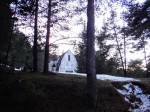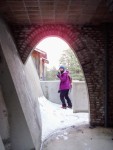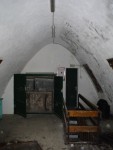El Xalet de Catllaràs is a mountain refuge by Antoni Gaudí completed in 1905 for workers of the Asland cement company owned then by Eusebi Güell, Gaudí’s principal patron. It is situated in the foothills of the Catalan Pyrenees at an altitude of almost 1400 m. Getting there requires hiking (or mountain-biking) 10 km uphill along a forest trail out of the small rural town of La Pobla de Lillet (where Gaudí also designed a private garden for the textile industrialist Joan Artigas).
The refuge sits all by itself on a small plateau in a clearing in the forest; a context that is radically different from the rest of Gaudí’s oeuvre. No tacky souvenir shops; no fast food joints whatsoever. When I went there with my hiking buddies on a recent weekend, there was nobody else to be seen anywhere for miles. Together with the snow and freezing cold temperature, it felt almost like being back in Canada.
Indeed, at first sight, Gaudí’s 1905 refuge is reminiscent of those 1950s North American “A-frame” cabins that are also typically situated in forests, except that Gaudí’s “A” has a rounded apex as well as curved stems, and is not a frame structure at all, but a masonry vault based on the geometry of a catenary or funicular, which Gaudí experimented with throughout his career.
Despite their structural differences, both the North American A-frame and Gaudí’s A-shape (or perhaps we should we call this an “A-chain”?) nevertheless have other features in common, most notably the fact that they were simple, cheap to build, and ideal for shedding snow, which is especially important in both Canada and the Pyrenees.
This mountain refuge is undoubtedly Gaudí’s most rational and restrained work. Here, far from sillyvization, Gaudí had to make the most efficient use of materials possible. No applied ornamentation here: only the roofing shingles near the top formed (originally) a decorative pattern resembling (what else?) catenaries, as can be seen in the archival photograph below.

El Xalet de Catllaràs in its early years (image courtesy Wikipedia)
Today, the refuge is surrounded by a construction fence –its round exterior stair having been recently reconstructed– though work on the rest of the structure, which is badly in need of repairs, seems temporarily halted.
It is really quite remarkable to find such an unusually sober Gaudí, and reassuring to discover that this architect’s work spans the entire spectrum of “seny i rauxa” (“common sense and unbridled impulse”, the Catalan version of yin and yang). This building proves that in addition to designing the finest homes for Barcelona’s élite or an XL temple for the Catholic Church, Gaudí was also perfectly capable of designing architecture on a shoestring in the middle of nowhere; adapting his forms, materials, and ways of working to the particular situation at hand. Isn’t that precisely the essence of architecture’s essential hut?
[mentally insert oft-published Laugier engraving here]
Source: Criticalista






